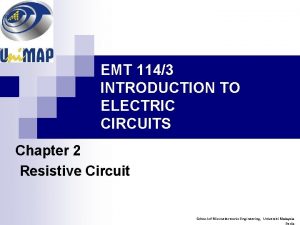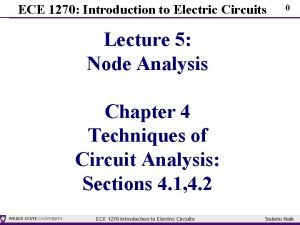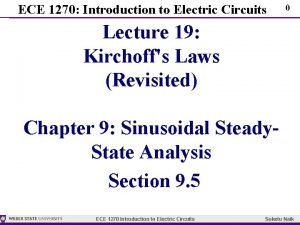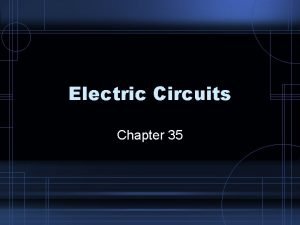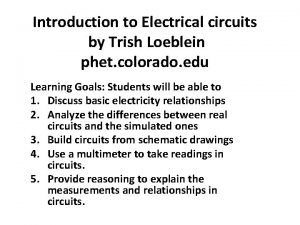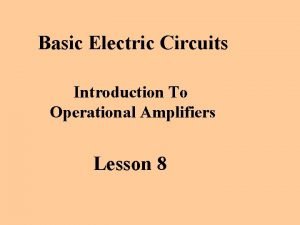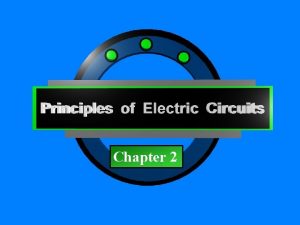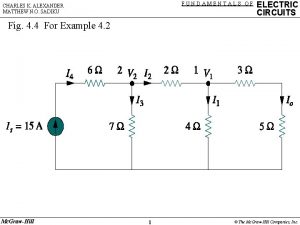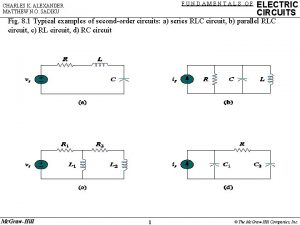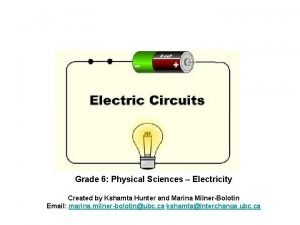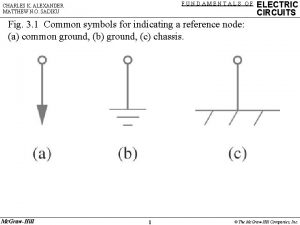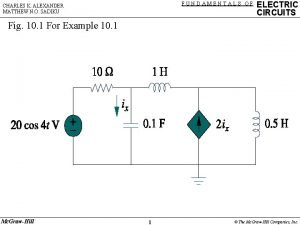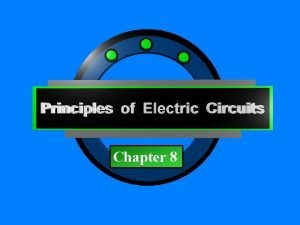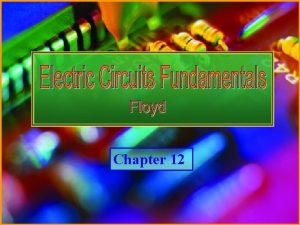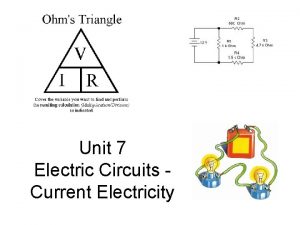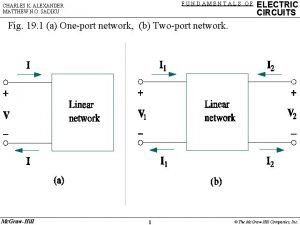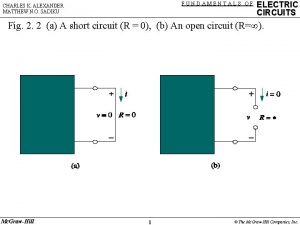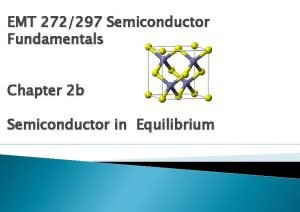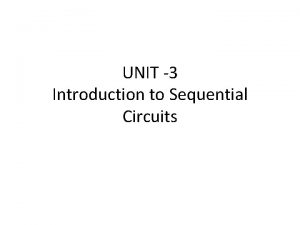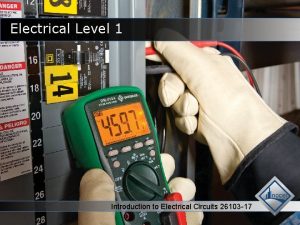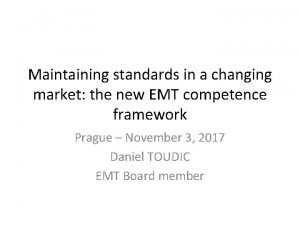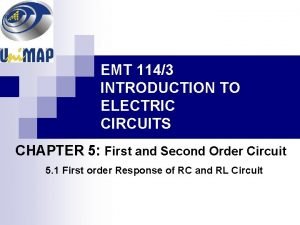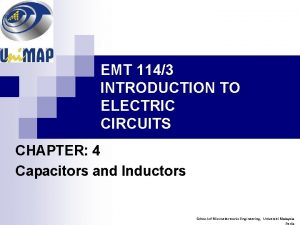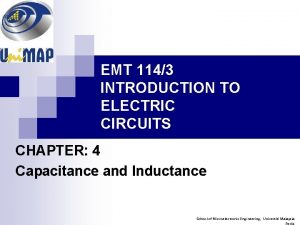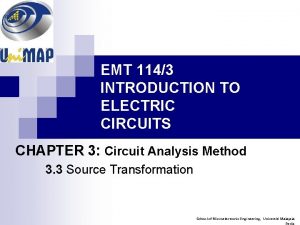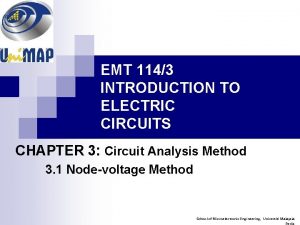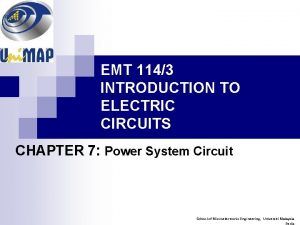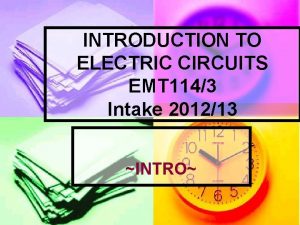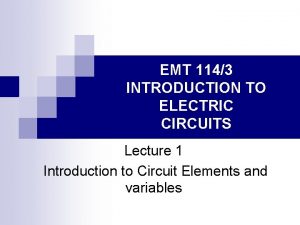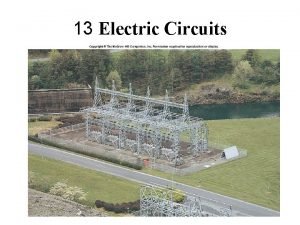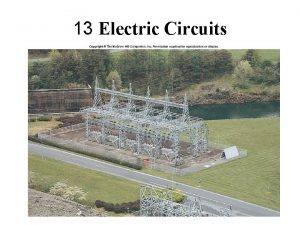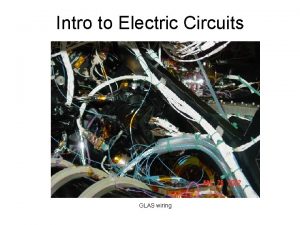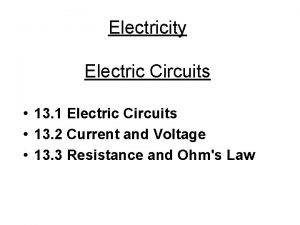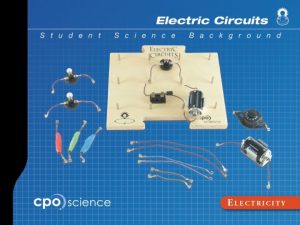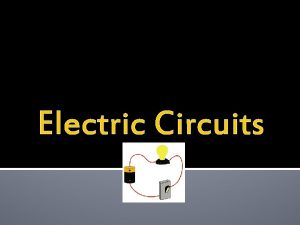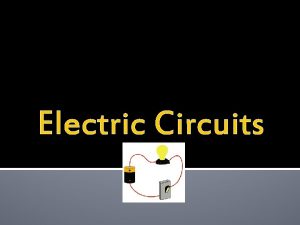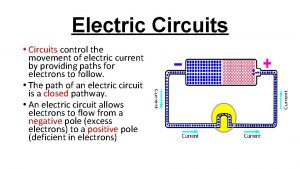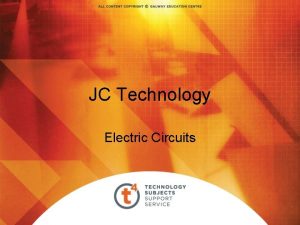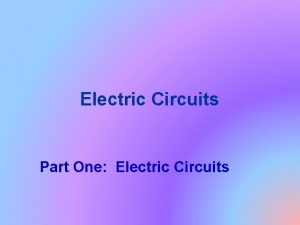EMT 1143 INTRODUCTION TO ELECTRIC CIRCUITS CHAPTER 6
















































- Slides: 48

EMT 114/3 INTRODUCTION TO ELECTRIC CIRCUITS CHAPTER 6: Sinusoidal Steady-State Analysis

STUDY WEEK LAB 3 ETE RLC w 12 w 11 w 10 sinusoidal w 13 3 phase w 14 w 15 2 Port

CHAPTER OUTLINE 6. 1 Sinusoids and Phasor 6. 1. 1 6. 1. 2 6. 1. 3 6. 1. 4 6. 1. 5 6. 1. 6 Sinusoids Phasor relationships for circuit elements Impedance and Admittance Kirchhoff’s Laws in the Frequency Domain Impedance Combinatiobbb 6. 2 Sinusoidal Steady-State Analysis 6. 2. 1 6. 2. 2 6. 2. 3 6. 2. 4 6. 2. 5 Basic Approach Nodal Analysis Mesh Analysis Source Transformation Thevenin and Norton Equivalent Circuits


6. 1. 1 Sinusoids Ø A sinusoid is a signal that has the form of the sine or cosine function. Ø A sinusoidal forcing function produces both a transient and a steady state response. Ø A sinusoidal voltage may be represented as: Vm = the amplitute of the sinusoid, ω = the angular frequency in radians/s ωt = the argument of the sinusoid Ø The function repeats itself every T seconds. . This is called the period:

6. 1. 1 Sinusoids Ø The period is inversely related to another important characteristic, the frequency: Ø Ø The units of this is cycles per second, or Hertz (Hz). It is often useful to refer to frequency in angular terms: Ø Here the angular frequency is in radians per second.

6. 1. 1 Sinusoids Ø Only two sinusoidal values with the same frequency can be compared by their amplitude and phase difference. Ø This can be done by including a phase shift, : Ø If phase difference is zero, they are in phase; if phase difference is not zero, they are out of phase.

6. 1. 1 Sinusoids Ø Sinusoids may be expressed as sine or cosine. Ø The conversion between them is:

6. 1. 1 Sinusoids Practice Problem 9. 1 Ø Given the sinusoid 30 sin (4πt - 75º), calculate its amplitude, phase, angular frequency, period, and frequency.

6. 1. 1 Sinusoids Practice Problem 9. 2

6. 1. 2 Ø Ø Phasors A phasor is a complex number that represents the amplitude and phase of a sinusoid. The complex number “z” can be written in rectangular, polar and exponential form. a. Rectangul ar b. Polar c. Exponenti Ø On the other hand, if we know r and al Ø Φ , we can obtain x and y as; x = r cosΦ , y = r sin Φ Thus, z may be written as where

6. 1. 2 Phasors Mathematic operation of complex number: 1. Addition 2. Subtraction 3. Multiplication 4. Division 5. Reciprocal 6. Square root 7. Complex conjugate 8. Euler’s identity Use rectangular form Use polar form

6. 1. 2 Ø Phasors Transform a sinusoid to and from the time domain to the phasor domain: (time domain) (phasor domain) Ø Amplitude and phase difference are two principal concerns in the study of voltage and current sinusoids. Ø Phasor will be defined from the cosine function in all our proceeding study. Ø If a voltage or current expression is in the form of a sine, it will be changed to a cosine by subtracting from the phase.

6. 1. 2 Ø Phasors Here is a handy table for transforming various time domain sinusoids into phasor domain:

6. 1. 2 Phasors Practice Problem 9. 3

6. 1. 2 Phasors Practice Problem 9. 3 Ø Evaluate the following complex numbers:

6. 1. 2 Phasors Practice Problem 9. 4

6. 1. 2 Phasors Practice Problem 9. 5 Don’t try this at home

6. 1. 2 Phasors The differences between v(t) and V: Ø Ø Ø v(t) is instantaneous or time-domain representation. V is the frequency or phasor-domain representation. v(t) is time dependent, V is not. Relationship between differential, integral operation in phasor listed as follow:

6. 1. 3 Phasor Relationships for Circuit Elements Ø Each circuit element has a relationship between its current and voltage. Ø These can be mapped into phasor relationships very simply for resistors capacitors and inductor. Resistor: Inductor: Voltage-current relations for element R, L, C in a) Time domain b) Frequency domain Capacitor:

6. 1. 3 Phasor Relationships for Circuit Elements Summary of voltage-current relationship Element R L C Time domain Frequency domain

6. 1. 3 Phasor Relationships for Circuit Elements Practice Problem 9. 6 If voltage v = 10 cos(100 t + 30 o) is applied to a 50 μF capacitor, calculate the current through the capacitor.

6. 1. 3 Phasor Relationships for Circuit Elements Practice Problem 9. 6

6. 1. 4 Impedance and Admittance Ø It is possible to expand Ohm’s law to capacitors and inductors. Ø The impedance, Z of a circuit may be expressed in rectangular form, which is the ratio of the phasor voltage, V to the phasor current, I, measured in ohms, Ω. where R = Re Z is the resistance and X = Im Z is the reactance. Ø The admittance Y is the reciprocal of impedance, measured in siemens (S).

6. 1. 4 Impedance and Admittance Impedances and admittances of passive elements Element R L C Impedance Admittance

6. 1. 4 Impedance and Admittance Ø It is important to realize that in frequency domain, the values obtained for impedance are only valid at that frequency. Ø Changing to a new frequency will require recalculating the values. Ø The impedance of capacitors and inductors are shown here:

6. 1. 4 Impedance and Admittance Practice Problem 9. 9 Refer to the circuit below. Determine v(t) and i(t).

6. 1. 5 Kirchhoff’s Laws in the Frequency Domain Ø After we know how to convert RLC components from time to phasor domain, we can transform a time domain circuit into a phasor/frequency domain circuit. Ø A powerful aspect of phasors is that Kirchoff’s laws apply to them as well. Ø This means that a circuit transformed to frequency domain can be evaluated by the same methodology developed for KVL and KCL. Ø One consequence is that there will likely be complex values.

6. 1. 5 Ø Ø Impedance Combinations Once in frequency domain, the impedance elements are generalized. Combinations will follow the rules for resistors:

6. 1. 5 Impedance Combinations Ø Series combinations will result in a sum of the impedance elements: Ø Here then two elements in series can act like a voltage divider

6. 1. 5 Ø Impedance Combinations Elements combined in parallel will combine in the same fashion as resistors in parallel:

6. 1. 5 Ø Impedance Combinations The Delta-Wye transformation is:

6. 1. 5 Impedance Combinations Practice Problem 9. 10 Determine the input impedance of the circuit in figure below at ω =10 rad/s.

6. 1. 5 Impedance Combinations Practice Problem 9. 11 Calculate v(0) in the circuit below.

Lab

6. 2 Sinusoidal Steady-State Analysis 6. 2. 1 6. 2. 2 6. 2. 3 6. 2. 4 6. 2. 5 Basic Approach Nodal Analysis Mesh Analysis Source Transformation Thevenin and Norton Equivalent Circuits

6. 2. 1 Basic Approach Steps to Analyze AC Circuits: 1. 2. 3. Transform the circuit to the phasor or frequency domain. Solve the problem using circuit techniques (nodal analysis, mesh analysis, etc. ). Transform the resulting phasor to the time domain. Time to Freq Solve variables in Freq to Time

6. 2. 2 Nodal Analysis Ø The basis of nodal analysis is Kirchhoff’s current law. Ø The final voltages and current calculated are the real component of the derived values. Ø The equivalency of the frequency domain treatment compared to the DC circuit analysis includes the use of supernodes.

6. 2. 2 Nodal Analysis Practice Problem 10. 1 Using nodal analysis, find v 1, v 2 and vx in the circuit of figure below.

6. 2. 2 Nodal Analysis Practice Problem 10. 2 Calculate V 1 and V 2 in the circuit of figure below.

6. 2. 3 Mesh Analysis Ø Kirchhoff’s voltage law (KVL) forms the basis of mesh analysis. Ø In KVL, supermesh analysis is also valid.

6. 2. 3 Mesh Analysis Practice Problem 10. 3 Find Io in the follow circuit using mesh analysis.

6. 2. 4 Source Transformation Ø Source transformation in frequency domain involves transforming a voltage source in series with an impedance to a current source in parallel with an impedance, or vice versa:

6. 2. 4 Source Transformation Practice Problem 10. 7 Find Io in the circuit of figure below using the concept of source transformation.

6. 2. 5 Thevenin and Norton Equivalent Circuits Thevenin transform Norton transform

6. 2. 5 Thevenin and Norton Equivalent Circuits Practice Problem 10. 8 Find the Thevenin equivalent at terminals a–b of the circuit below.

6. 2. 5 Thevenin and Norton Equivalent Circuits Practice Problem 10. 10 Determine the Norton equivalent of the circuit in the figure below as seem from terminal a-b. Use the equivalent to find I 0.

Ilmu Keikhlasan Kecemerlangan
 Introduction to electric circuits
Introduction to electric circuits Introduction to electric circuits
Introduction to electric circuits Introduction to electric circuits
Introduction to electric circuits Fundamentals of electric circuits chapter 4 solutions
Fundamentals of electric circuits chapter 4 solutions Electric current
Electric current Chapter 35 electric circuits
Chapter 35 electric circuits Chapter 20 electric circuits
Chapter 20 electric circuits Fundamentals of electric circuits chapter 9 solutions
Fundamentals of electric circuits chapter 9 solutions Fundamentals of electric circuits chapter 7 solutions
Fundamentals of electric circuits chapter 7 solutions Chapter 35 electric circuits answers
Chapter 35 electric circuits answers Worksheet circuits and ohm's law answer key
Worksheet circuits and ohm's law answer key Chapter 35 electric circuits
Chapter 35 electric circuits Current in a parallel circuit
Current in a parallel circuit Chapter 21 electric charge and electric field
Chapter 21 electric charge and electric field Chapter 21 electric charge and electric field
Chapter 21 electric charge and electric field Electric force
Electric force Units of a charge
Units of a charge Phet ac circuit
Phet ac circuit Electric circuits equations
Electric circuits equations Electric circuits by james nilsson and susan riedel
Electric circuits by james nilsson and susan riedel Principle of electric circuit
Principle of electric circuit What three elements are required for all electric circuits
What three elements are required for all electric circuits Charles k. alexander matthew n. o. sadiku
Charles k. alexander matthew n. o. sadiku Fundamentals of electric circuits
Fundamentals of electric circuits Superposition electric circuits
Superposition electric circuits Electric circuits grade 6
Electric circuits grade 6 Alexander sadiku
Alexander sadiku Sadiku
Sadiku Principles of electric circuits 10th edition answer key
Principles of electric circuits 10th edition answer key Electric circuits fundamentals floyd
Electric circuits fundamentals floyd Physics reference table
Physics reference table Alexander
Alexander Fundamentals of electric
Fundamentals of electric Quarturs
Quarturs Analogy between electric and magnetic circuits
Analogy between electric and magnetic circuits A 23 year old male experienced severe head trauma
A 23 year old male experienced severe head trauma Emt chapter 18 gastrointestinal and urologic emergencies
Emt chapter 18 gastrointestinal and urologic emergencies Medical legal and ethical issues chapter 3
Medical legal and ethical issues chapter 3 Emt chapter 14 medical overview
Emt chapter 14 medical overview Emt chapter 2
Emt chapter 2 Electric field energy
Electric field energy Joules per coulumb
Joules per coulumb Electrical potential energy
Electrical potential energy Electric field from electric potential
Electric field from electric potential A suitable electric pump in an electric circuit is a
A suitable electric pump in an electric circuit is a Electric charges and electric forces lesson outline
Electric charges and electric forces lesson outline D flip flop truth table
D flip flop truth table Nccer introduction to electrical circuits
Nccer introduction to electrical circuits Emt competence framework
Emt competence framework
